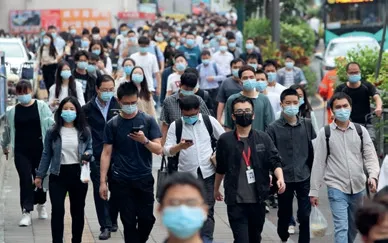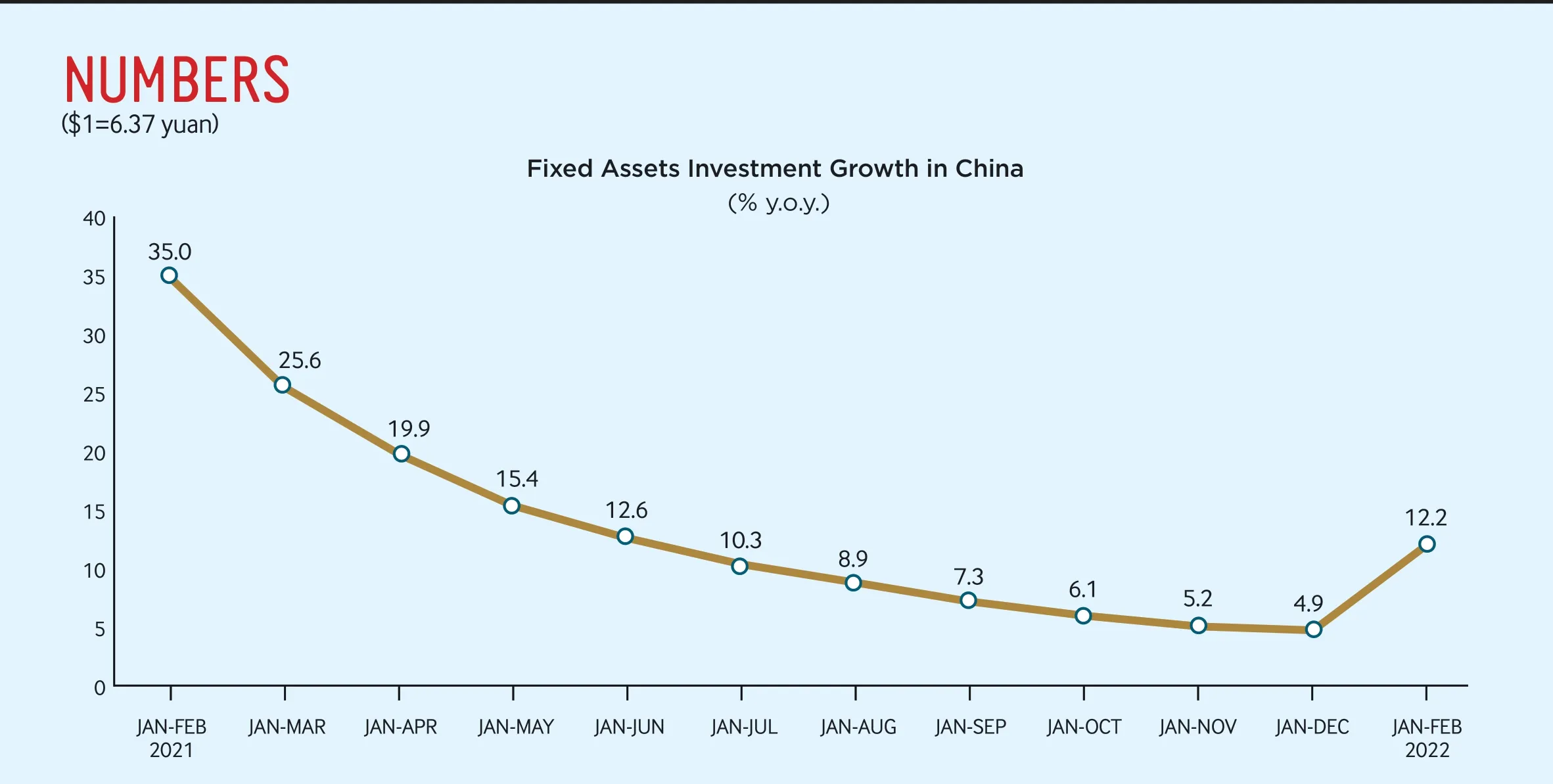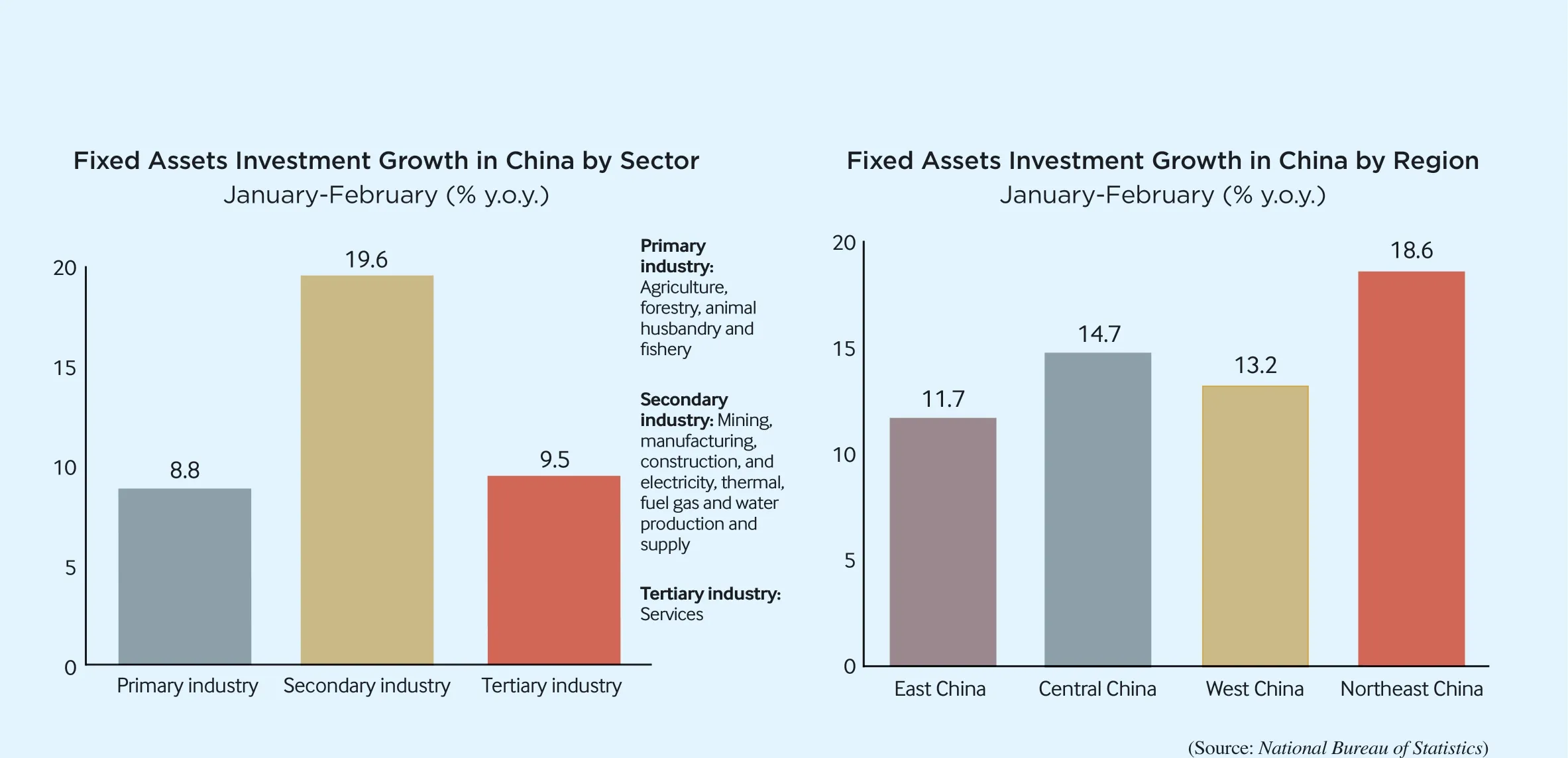THIS WEEK
LESSONS FROM SPACE

Students attend a live-stream popular-science lecture by the-crew members on March 23.
The second live class from China’sspace station lasted 45 minutes. It was delivered by taikonauts Zhai Zhigang, Wang Yaping and Ye Guangfu and attended by students from three classrooms across China.
Wang, assisted by the other two crew members, conducted several scientific experiments, such as the crystallization from a supersaturated solution, a liquid bridge demonstration, water-oil separation and throwing objects under zero-gravity conditions.
Back to Business

Residents of Shenzhen in Guangdong Province are on their way to work at one of the city’s industrial parks on March 21. Government offices and businesses in the southern Chinese metropolis resumed normal work and production on March 21 as the latest COVID-19 resurgence there began to subside.
Canal Project
Development of a new canal project in Guangxi Zhuang Autonomous Region has been approved, Xinhua News Agency reported on March 20.
The Pinglu Canal, stretching 140 km with an estimated investment of 68 billion yuan($10.69 billion), aims to link the Xijiang River, a major waterway in southwest China, with ports in the Beibu Gulf.
The canal will begin at the Xijin reservoir in Hengzhou City and end at Luwu Town of Lingshan County, where ships will be able to reach the Beibu Gulf via the Qinjiang River, opening a shorter route to the sea for Guangxi and other regions in southwest China.
Local authorities are preparing to begin project construction this year, according to the region’s department of transport.
Bird Protection
Honghe National Nature Reserve in Heilongjiang Province has built 100 new artificial nests for oriental white storks, an endangered bird species, Xinhua reported on March 20.
The oriental white stork, a migratory bird species under first-class national protection,has been listed as endangered by the International Union for Conservation of Nature.
At the beginning of this year,the reserve added 100 artificial bird nests, made of metal instead of wood to be more durable.
With a total area of 21,835 hectares, the reserve is dubbed“China’s home of oriental white storks,” and is also a major breeding habitat for many other rare migratory birds.
To restore the population of the endangered stork, the nature reserve has built 389 artificial nests since 1993. By the end of 2021, it had successfully helped the wild species breed 1,748 oriental white stork fledglings.
Ice Cube
The National Aquatics Center or“Ice Cube,” which hosted curling events during the Olympic Winter Games Beijing 2022, will be open to the public in April.
Yang Qiyong, general manager of the center, told Xinhua on March 20 that its Winter
Olympic image landscape, spectator stands and curling rinks are fully preserved for post-Games visits, while mascots Bing Dwen Dwen and Shuey Rhon Rhon will still be present.
It will offer the public a taste of the Olympics and help spread Winter Olympic culture.
The curling rink will be converted back into a swimming pool in June as the “Ice Cube”resumes its former identity as the “Water Cube,” while the amusement park and the heated swimming pool will also welcome the public before the summer vacation.
The underground ice sports center on the south side of the“Ice Cube” will open to the public for the first time in May.
The two ice rinks will be available all year round, with the 1,000-square-meter one set to become a permanent venue for curling competition and training,and the 1,830-square-meter one to serve figure skating, ice hockey and ice performances.
At the end of the year, the center will once again host international curling competitions.
Groundwater Overexploitation
The overexploitation of groundwater has been eased in China in recent years amid the country’s efforts to do so and to increase water replenishment, said the Ministry of Water Resources,Xinhua reported on March 21.
In 2020, the country used 89.25 billion cubic meters of groundwater, down 24.2 billion cubic meters from 2012, data from the ministry showed.
In recent years, China’s comprehensive management of groundwater overexploitation at the local level has achieved gradual progress, said Yang Derui, an official with the ministry.
In China’s water-deficient northern region, groundwater exploitation has been curbed by saving water and adjusting the agricultural structure while increasing water supply through multiple methods and replenishing groundwater from rivers and lakes.
At the end of 2021, the overall level of shallow groundwater in the controlled area of the Beijing-Tianjin-Hebei region had raised 1.89 meters from the same period of 2018, while that of deep confined water had climbed 4.65 meters on average.
Nearly 8 billion cubic meters of groundwater had been replenished by rivers and lakes as of 2021, said the ministry, adding it will focus on 11 key regions nationwide and further strengthen the control of groundwater overexploitation.
Agricultural Production
China’s top economic planner has detailed tasks to boost agricultural production, urging efforts to stabilize grain output,expand the planting of soybean and oilseed crops, and ensure the supply of farm produce,Xinhua reported on March 18.
Vigorous efforts should be made to expand the planting of soybean and oilseed crops to support coordinated development between grain and oilseed crops production, said the circular released by the National Development and Reform Commission.
The economic planner also called for close attention to the supply and demand of live pigs, pledging to take targeted measures to stabilize the basic production capacity and prevent fluctuations.
Other measures aimed at boosting agriculture production include strengthening the construction of agriculture infrastructure and stabilizing prices of agricultural materials, including fertilizers.
China has set a target to ensure the full-year grain output stays above 650 billion kg in 2022. Last year, China’s grain output hit a new high of 683 billion kg, with grain-producing farmland exceeding 117.3 million hectares.
Hydropower Plant
With the last 500,000-kW power generation unit officially put into use, a mega hydropower plant built at an average altitude of 3,000 meters, the highest of its kind in China, became operational on March 18.
With a planned total installed capacity of 3 million kW, the Lianghekou Hydropower Plant is located on the Yalong River in the Garze Tibetan Autonomous Prefecture in Sichuan Province.
Construction of the project,with an approved investment of 66.5 billion yuan ($10.5 billion),started in October 2014 and is expected to be fully completed by 2023, according to the Yalong River Hydropower Development Company.
Storage capacity of the reservoir is designed to reach 10.8 billion cubic meters, and annual power generation volume is expected to surpass 11 billion kWh.
The Yalong River basin is one of China’s clean energy bases.The operation of the Lianghekou Hydropower Plant will help ease imbalanced power generation in Sichuan and promote the high-quality development of the Yangtze River Economic Belt and the Chengdu-Chongqing Economic Circle.
Clean and Clear

A local resident out with her granddaughter on a walkway on the bank of the Meishe River in Haikou, Hainan Province, on March 19. Dubbed the mother river of Haikou, the Meishe was recently listed among the country’s 11 most beautiful hometown rivers by the Ministry of Water Resources.
A Brocade Buffet

A visitor browses brocade products at a cultural creative product demonstration center in a village in Chongqing Municipality on March 22. The village has been developing brocade, a national intangible cultural heritage, and related cultural creative products in recent years to promote rural revitalization.
Energy Targets
By 2025, annual domestic energy production capacity will exceed 4.6 billion tons of standard coal equivalent, according to a plan jointly released by the National Development and Reform Commission and the National Energy Administration on March 22. The plan specifies targets for creating a modern energy system during the 14th Five-Year Plan (2021-25) period.
By 2025, the annual crude oil output will recover and stabilize at 200 million tons, and the annual natural gas output will reach over 230 billion cubic meters.
The plan places emphasis on efforts to advance the large-scale and high-quality development of wind and solar power generation. Nuclear power will be developed in an active, safe and orderly manner, with the goal of elevating the installed capacity to roughly 70 million kW by 2025.
While boosting energy output, the country is also seeking to reduce its carbon dioxide emissions per unit of GDP by 18 percent during the five-year period.
The share of non-fossil fuels in energy consumption and generation will improve to approximately 20 percent and 39 percent, respectively.
Energy consumption per unit of GDP will be lowered 13.5 percent.
China-EU Trade
China-EU trade jumped 14.8 percent year on year to $137.16 billion in the first two months of this year, making the EU China’s largest trading partner during the period, Gao Feng, spokesperson for the Ministry of Commerce,said on March 17.
As significant trading partners to one another, China and the EU enjoy a high degree of economic complementarity,broad areas of cooperation, and great potential for development,Gao said.
China is ready to work with the EU to further liberalize and facilitate trade and investment and safeguard the stable and smooth operation of industrial and supply chains, he added.
Bond Issuance
The value of local government bond issuance stood at 507.1 billion yuan ($80 billion) in February,official data showed on March 22.
Of the total, the issuance of general bonds totaled 111.7 billion yuan ($17.5 billion), while the special bond issuance came in at 395.4 billion yuan ($62 billion), the Ministry of Finance said in a statement. The bonds had an average maturity term of 15.1 years and an average interest rate of 3.16 percent.
The additional issuance in February brought the total amount in the first two months of this year to about 1.21 trillion yuan ($190 billion).
At the end of February, outstanding local government debt stood at around 31.64 trillion yuan ($4.97 trillion).
In 2021, the bond issuance by local governments totaled 7.49 trillion yuan ($1.18 trillion).
Financial Assets
Chinese financial institutions saw their combined assets increase 8.1 percent year on year to 381.95 trillion yuan ($60.22 trillion) by the end of 2021, while their combined liabilities rose 7.9 percent from a year earlier to 346.58 trillion yuan ($54.4 trillion), data from the People’s Bank of China showed.
Banking institutions, accounting for the lion’s share of the financial industry, reported a 7.8-percent rise in total assets,while companies in the securities industry saw their combined assets jump 21.2 percent year on year.
The insurers reported combined assets of 24.89 trillion yuan ($3.9 trillion), up 6.8 percent year on year.

Overseas Investment
China’s non-financial outbound direct investment reached 100.26 billion yuan ($15.8 billion) in the first two months of 2021, up 0.9 percent year on year, official data showed on March 17.
In U.S. dollar terms, it rose 2.7 percent from a year ago, according to the Ministry of Commerce.
Investment in other Belt and Road Initiative participating countries increased 3.6 percent year on year to $3.16 billion.
Wholesale and retail investment surged 89.7 percent from a year earlier to $3.49 billion,while that in scientific research,technical services, and transportation also increased, the ministry said.
Postal Revenue
The postal industry reported a robust increase in business revenue in the first two months of this year, according to the State Post Bureau.
The sector raked in a total of 216.8 billion yuan ($34.18 billion)during the period, up 15.7 percent year on year.
In February alone, its business revenue grew 27.3 percent year on year to 89.69 billion yuan ($14.1 billion).
Express delivery companies handled 15.69 billion parcels in the first two months, surging 19.6 percent from a year earlier.Their business revenue amounted to 157.4 billion yuan ($24.7 billion) during the period, an increase of 13.8 percent year on year.
Integrated Circuit
The integrated circuit industry registered stable growth in 2021 with sales exceeding 1 trillion yuan ($158 billion) for the first time, data from the China Semiconductor Industry Association showed.
Sales volume surged 18.2 percent year on year to 1.05 trillion yuan ($165 billion) last year.
In breakdown, sales from the design sector increased 19.6 percent from a year earlier to 451.9 billion yuan ($71 billion), while those from the manufacturing sector jumped 24.1 percent to
317.63 billion yuan ($49.9 billion).
China has remained the world’s largest semiconductor market, with 2021 sales totaling$192.5 billion, up 27.1 percent year on year, the data demonstrated.
Cargo Airport
China’s first cargo airport in Ezhou, Hubei Province, completed its flight test on March 19.
Ezhou Huahu Airport is also Asia’s first and the world’s fourth air cargo hub. Its passenger throughput is designed to reach 1 million, with cargo and mail throughput hitting 2.45 million tons, in 2025.
The airport, with two runway and taxiway systems and a freight transfer center covering nearly 700,000 square meters,is expected to open to traffic in late June.
Wearable Devices
In 2021, total shipments of Chinamade wearable devices rose 25.4 percent year on year to nearly 140 million units, according to an industry report published by global market research firm International Data Corp.
The volume of ear-worn devices surged 55.4 percent from 2020 to 78.98 million units, while that of watches rose 21.4 percent to 39.56 million units.
Shipments of wristbands,however, went down 26.3 percent year on year to 19.1 million units last year.
The country is expected to ship 160 million units of wearable devices in 2022, up 18.5 percent from the previous year,according to the report.


SERBIA Serbian President Aleksandar Vucic (right)and Hungarian Prime Minister Viktor Orban attend the inauguration ceremony of the Belgrade-Novi Sad section of the Belgrade-Budapest Railway in Novi Sad on March 19. This railway will bring the Balkans closer to Central Europe

SENEGAL President Macky Sall speaks at the opening ceremony of the Ninth World Water Forum themed Water Security for Peace and Development in Dakar on March 21

PAKISTAN Soldiers march during the Pakistan Day military parade in the capital of Islamabad on March 23. The event marked the passing of the Lahore Resolution on March 23, 1940, a major milestone in the country’s struggle for independence

FRANCE President Emmanuel Macron presents his program for April’s presidential election during a press conference in Aubervilliers, Seine-Saint-Denis, on March 17


UNITED STATES People inspect their damaged home after tornadoes plowed through Round Rock, Texas,on March 22. One person was killed and more than two dozen were injured as the devastating storms hit large areas of Texas and Oklahoma
POLITICIAN AND PEDIATRICIAN DIES AT 88
He Luli, former vice chair of the Standing Committee of the National People’s Congress (NPC), passed away at the age of 88 on March 19.
She was a Chinese politician and pediatrician. After the founding of the People’s Republic of China in 1949, she studied medicine at Beijing Medical University (now Peking University Health Science Center) from 1952 to 1957.Starting in 1957, she worked as a doctor at Beijing Children’s Hospital, Xicheng District Children’s Hospital in Beijing, and Beijing No.2 Hospital.
He entered politics after practicing medicine for 27 years. She served as deputy head of Beijing’s Xicheng District, vice mayor of Beijing, chair of the Revolutionary Committee of the Chinese Kuomintang, vice chair of the National Committee of the Chinese People’s Political Consultative Conference, and vice chair of the Standing Committee of the NPC.

The cutoff mark for the 2022 postgraduate reexamination has been raised due to the extreme number of undergraduates participating in the assessment.According to the Ministry of Education,some 4.57 million sat the exam, while in 2003, that number was 797,000.
Why hasn’t the postgraduate examination hype died down already? The primary reason is the rising educational requirement for job applicants. With increased college education popularity comes a devaluation of the college degree.
A master’s degree has almost become the threshold for any successful job application, which means the postgraduate exam is gradually taking on the role of the college entrance examination. Many students go to great lengths to prepare for the assessment, often even outpacing their middle school efforts. Colleges also support this trend, because high postgraduate acceptance rates in turn help them attract more freshmen.
Undergraduate schooling is the foundation of any college education. Too much time spent preparing for the postgraduate examination will lead to a declining academic research and innovation capability among undergraduate students, which subsequently could pose a threat to the quality of postgraduate education.
“The worst human rights violator in the world is the United States itself…If the United States were to stop lecturing everybody else on human rights, the situation of human rights in the world would get better.”
Wang Wenbin, spokesperson for the Foreign Ministry,demanding that the U.S. immediately revoke sanctions imposed against Chinese officials at a regular news briefing on March 22
“The pandemic has affected everyone in society, but the most vulnerable, including children and young people, have suffered the most.”

On March 2, the Ministry of Public Security launched a special awareness campaign targeting the trafficking of women and children; it will run until December 31.
Gender equality is one of China’s
Dr. Hans Kluge, Regional Director for Europe of the World Health Organization (WHO), at the launch ceremony of a child mental health program by the WHO Regional Office for Europe in cooperation with the Greek Government on March 21 fundamental national policies, but trafficked women are, to this day, often seen as a tool to continue the family line of their male buyers.
China is still a developing country, long plagued by regional and economic imbalances. Men do still hold a dominant position in society,especially in the more remote areas. In those places, bachelors in their 30s and up often receive much criticism from their surroundings and so some choose to buy a wife to have babies.
The Chinese Government has always taken a tough stance on this crime. From 1991 to 2000, the ministry organized four campaigns targeting women trafficking. The maximum penalty imposed on human traffickers is the death sentence; buyers, too, are guilty as charged. Their demand and funding encourage the crime to persist and consequently, their penalties must be stepped up.
Society by large should stand up to human trafficking as well as to all forms of discrimination against women.
For safety reasons, local governments across many provinces have recently started banning male migrant workers over the age of 60 from working in the construction industry; the age ceiling for females is 50. But many of the workers are more concerned about their future income than they are about their safety.
Most of them work in construction to relieve the economic burdens on their children or save up a little more for their golden years. The sector is among the very few allowing them to bring home a relatively good paycheck at their age.
This group has made vast contributions to China’s urbanization drive. They deserve to share in the fruits of China’s rapid economic growth as they grow older. For those who still intend to, and can, do some type of work, transitional training is a necessary tool in the box to take on security or cleaning jobs.
ATHLETE POTENTIALLY SET TO RECEIVE LONDON 2012 GOLD
China’s Qieyang Shijie is expected to be promoted to first place in the women’s 20km race walk at the Olympic Games London 2012, following original Russian champion Elena Lashmanova’s disqualification due to a doping violation.
The Athletics Integrity Unit, an organization independent from World Athletics, the international governing body for the sport of athletics, posted on Twitter that Lashmanova in March accepted a two-year ban, retroactive to March 2021, and all of her results being disqualified from February 18, 2012, to January 3, 2014, for the use of prohibited substances, a direct violation of the World Athletics anti-doping rules.
Prior to Lashmanova, Russia’s Olga Kaniskina had been stripped of her silver medal. Qieyang Shijie, who originally finished third in the race, could therefore receive the gold medal,which would make her China’s first Olympic gold medalist from the Tibetan ethnic group.

“What China is doing, is sending food,medicine, sleeping bags and baby formula; not weapons and ammunition to any party… China is part of the solution. It’s not part of the problem.”
Qin Gang, Chinese Ambassador to the U.S., during a televised interview on CBS on March 20
“Realizing the vision of a world free of racism and racial discrimination demands action every day, at every level, in every society.”
António Guterres, UN Secretary General, at a commemorative meeting of the General Assembly on the occasion of the International Day for the Elimination of Racial Discrimination on March 18

